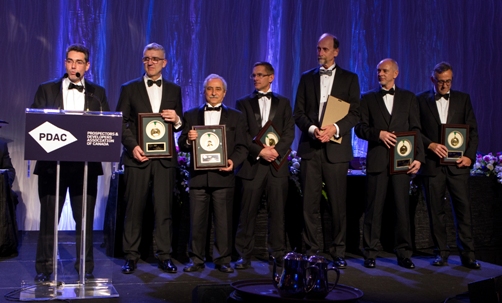PDAC 2016 – Thayer Lindsley Award – Reservoir Minerals & Freeport from PENDA Productions on Vimeo.
http://www.pendaproductions.com/ This video was produced by PENDA Productions, a full service production company specializing in Corporate Communications with a focus on Corporate Responsibility.

This award recognizes an individual or a team of explorationists credited with a recent significant mineral discovery anywhere in the world.
Cukaru Peki Discovery Team/Reservoir Minerals & Freeport McMoRan: For the team’s discovery of high-grade copper-gold deposits in Serbia which may prompt explorers to look for a new class of mineral deposit.
In July 2012, a joint venture of subsidiaries of Reservoir Minerals Inc. and Freeport-McMoRan Inc. announced the discovery of what became known as the Cukaru Peki copper-gold deposit in the heart of Serbia’s Bor mining camp, which has been operating for more than 100 years.
In January 2014, Reservoir reported Inferred resources at Cukaru Peki, compliant with NI 43-101, of FreeportMcMoRan-LogoResize65.3 million tonnes grading 2.6% copper and 1.5 g/t gold. This included 4.5 million tonnes grading 11.2% copper and 7.4 g/t of gold. Some observers speculate that the deposit could contain over a billion tonnes of mineralization grading over 1.2% copper equivalent.
Traditional down-hole geophysics did not work at Cukaru Peki because the mineralization was too rich to respond as expected. The mineralization is dominated by bornite (63% copper), chalcocite (80% copper) and covellite (50% copper). All of these minerals appear to be primary.
For comparison, most of the world’s primary copper mineralization occurs as chalcopyrite (34.5% copper).Traditional down-hole geophysics did not work at Cukaru Peki because the mineralization was too rich to respond as expected. The mineralization is dominated by bornite (63% copper), chalcocite (80% copper) and covellite (50% copper). All of these minerals appear to be primary.
For comparison, most of the world’s primary copper mineralization occurs as chalcopyrite (34.5% copper).Traditional down-hole geophysics did not work at Cukaru Peki because the mineralization was too rich to respond as expected. The mineralization is dominated by bornite (63% copper), chalcocite (80% copper) and covellite (50% copper). All of these minerals appear to be primary. For comparison, most of the world’s primary copper mineralization occurs as chalcopyrite (34.5% copper).
The mineralization at Cukaru Peki does not fit well with porphyry copper, VMS, or epithermal models. Its discovery may prompt explorers to search for a new class of mineral deposit.
Cukaru Peki is exceptional because it was a blind discovery in an established mining camp—it is large, of high grade and could result in the establishment of a new geological model, providing targets for future explorers to seek.























